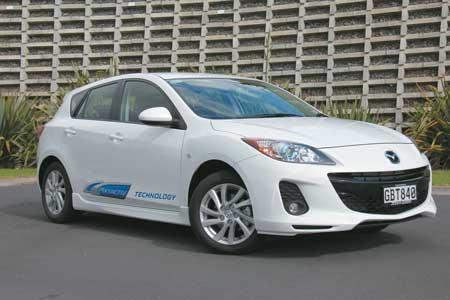|
Robert Barry gets to grips with the technologies behind the launch of the new Skyactiv equipped Mazda3 GSE
IIf you are not familiar with the green technology branding of BlueMotion, EfficientDynamics, EcoNetic, and EcoLine used by other car manufacturers, then Mazda’s Skyactiv Technology will possibly cause you even greater confusion.
That was the general reaction from many friends to the white Mazda3 GSE long term test car which arrived with “Skyactiv Technology” emblazoned in film across its flanks. Some wondered if I had changed jobs and was working for a new company. Fortunately they were mistaken.
In short Skyactiv is Mazda’s generic branding for its range of environmentally friendly technology, and this extends from engines and transmissions to body panels and construction.
Mazda is not reinventing the wheel but rather refining it. Instead of pursuing hybrids or electric vehicles it has decided to make more efficient engines and transmissions, and develop lighter and stronger body panels as well as better and lighter methods of construction.
The first car to benefit from Skyactiv-G engine technology is the Mazda3 GSE which has joined the 2012 range as a model in its own right.
You have to be a Mazda train spotter to pick the difference between the new GSE that is equipped with the all-new Skyactiv-G 2-litre engine and idle-stop, but there are some subtle differences.
The GSE sports headlamps with a blue detail around them, as well as a blue engine cover, blue instrument illumination and a discrete Skyactiv badge on the tailgate. Inside the cabin is very similar to GSX models, with cloth upholstery, Bluetooth telephony, climate air conditioning, cruise control and a stereo with aux input but no USB connection.
Regardless of the specification differences, fleet buyers will be happy to know that according to Mazda the new GSE model delivers more engine power and torque, but most importantly a 25 percent reduction in fuel consumption.
The 113kW/194Nm 2-litre engine in the GSE is completely different from the 108kW/182Nm 2-litre engine found in other Mazda3 models. The Skyactiv-G is a high-compression, long-stroke, direct injection engine that averages 6.1L/100km as an automatic compared with the 8.2L/100km of its siblings.
For the New Zealand market Mazda has chosen to run a version of the engine which will happily potter along on 91 octane petrol as that is the preferred fuel of most fleet users. Despite this the NZ-spec Skyactiv engine still runs a compression ratio of 12.1:1 but the 95 octane version in other export markets can run a diesel-like compression ratio of 14.1:1. It is unlikely that we will see this version of the Skyactiv-G engine in the market in the short term.
The fuel economy is assisted by the all-new 6-speed transmission which Mazda says combines the sporty character of a dual clutch transmission with the frugality of CVT.
The Skyactiv transmission has a small torque converter (about half the size of a traditional unit) to move the car off from standstill, when a large multi-plate clutch joins in to lock up the transmission in each gear to provide a more direct feel and better fuel economy.
The ratios are widely spread so sixth is a very tall gear designed specifically for touring and motorway runs.
My initial reaction to the GSE is that it didn’t feel as sprightly or responsive as the earlier models, and this is possibly down to the gearing – the engine certainly seems willing enough.
However, because Company Vehicle elected to run the GSE over the Christmas and New Year holiday period it gave me a bit more time than our usual road test to quickly acclimatise to the different engine/gearbox character, and I was surprised by how quickly this happened.
|
The GSE is most happy when living in day-to-day conditions by being driven with a light throttle and using the engine’s torque to quietly pull the car through those six gears quickly and efficiently. It’s quiet too, I think possibly due to further sound insulation in the cabin.
By all means you may prod the accelerator firmly and the car will respond with a busy 4-cylinder growl – but there’s no need to do this. Far better to let the torque of the engine do the work and give you a longer journey between fuel stops.
On that note, the idle stop system (or I-stop in Mazda-speak) deserves a mention for its ability to quickly fire the engine up as soon as you lift your right foot off the brake pedal.
In contrast to other systems from other manufacturers that require larger capacity starter motors and batteries, Mazda uses a system called “Combustion + Motor Assist” which primes the cylinders, firing up the engine using combustion in just 0.35 seconds.
It works very effectively and I never once worried about the car failing to start. But the system will not engage in certain circumstances, such as when the air conditioning is operating at maximum capacity, or if the rear window is defrosting. You can also deactivate it if you wish to by pressing the I-Stop button on the dash.
As for the much vaunted improvement in fuel economy – well here comes the truth.
Sadly, despite my best efforts I seemed to sit on an average fuel consumption of 8.4L/100km. But in fairness to the GSE most of that was short urban runs, so with a concerted effort to drive economically, I managed one morning to achieve 6.5L/100km on a motorway run into the office and another colleague managed to get 5.0L/100km in economy run conditions. So the GSE will provide the economy that Mazda says it will.
|



